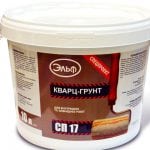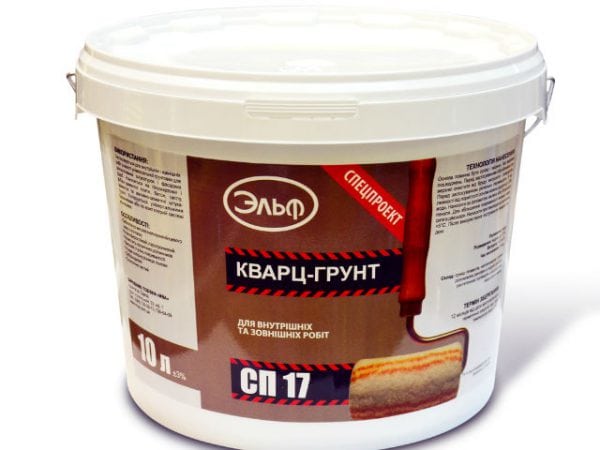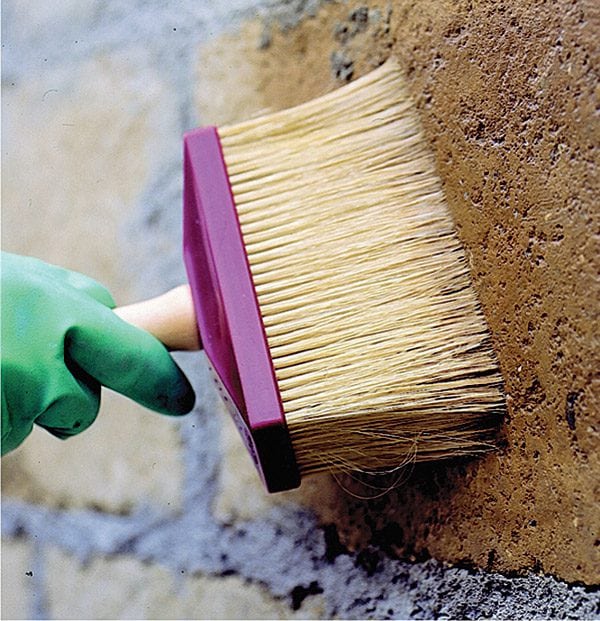The usual smooth primer in most cases does not contribute to improved adhesion of the adhesive to the surface of the ceramic tile or plaster to the wall surface. Accordingly, the consumption of these materials increases and the complexity of their application increases. Unlike traditional primers, quartz primers, on the contrary, increase the adhesion of surfaces to each other.
Composition and features
The water-dispersion base of most varieties of quartz putty is supplemented with fine crystalline sand. Sometimes it is used to achieve a purely visual effect, as a complement to decorative plaster. Then, using tinting additives, you can change the traditional white color of the quartz primer.
The composition of the quartz primer includes:
- Acrylic, acrylic-latex or latex compositions, due to which the material is well retained on any wettable surface.
- Bactericidal additives that improve the durability of the final coating in high humidity conditions.
- Resins and emulsifiers that contribute to a more uniform composition.
- Coloring pigment, which is used as titanium dioxide.
Although the appearance of the initial surface is not of particular importance, the use of this type of primer is especially justified for smooth but porous surfaces - for example, concrete or chipboard.
It is in this case that the surface roughness increases most noticeably, which ultimately leads to better retention of ceramic tiles, plaster and putty on it. This is especially true if, due to the characteristics of the wall, the listed materials must be applied with a sufficiently thick layer - more than 20-30 mm. In addition, the consumption of plaster is also reduced. In such cases, it is better to prime with a pre-fixed mesh.
to contents ↑Surface application
Since the material of such a primer is non-toxic (does not contain any solvents), there is no need to work in well-ventilated areas. There are no restrictions on the temperature in the room (except for negative ones).
The nuances of using a quartz primer relate to the following:
- The acrylic component of the material dries relatively slowly. Therefore, in enclosed spaces (toilet, bathroom), where priming works are carried out, the level of relative humidity may increase.
- Do not use a spray gun or spray gun - fine-grained sand quickly clogs outlet openings, which are very difficult to clean.
- The consumption of such a primer is greater than for traditional compositions, but this is justified by the technological purpose of the material - to increase the adhesion of the treated surface.
- The absence of volatile components, as well as high viscosity allows single-layer surface treatment.
to contents ↑As with other primers, high-quality cleaning of the original surface is important.Mandatory in this case is a more thorough mixing of the composition and the uniformity of the coating of the treated surface, so that there are no spots on it.
Work restrictions
Due to the nature of the composition, it is not recommended to use several types of primer in the same room.
So, it does not make sense to use a quartz primer when painting metal or plastic surfaces: they do not absorb the material, and after it dries, the sand quickly crumbles from the primed surface. For the same reason, it is not recommended to apply the material to walls, which during their drying will be exposed to direct ultraviolet radiation from the sun. And categorically it is not necessary to prime the ceilings with such compositions - at the slightest fluctuation in relative humidity, the sand will crumble.
In what cases is the greatest efficiency achieved by using a quartz primer? Experts point to the following rational cases of its use:
- Finishing poorly aligned walls, to fix surface defects, which are either impossible or difficult.
- In order to reduce the consumption of decorative plaster, which will be used to finish part of the wall in the room.
- For processing monolithic concrete walls.
- Quartz primers containing sodium silicate are well suited to form a translucent surface on a wall.
Some brands do not exclude the use of coatings for the decoration of facades of individual houses. The decisive factor is the reduced consumption of such a composition, as well as great opportunities for a spectacular exterior decoration. However, it is worth recalling that all quartz primers are made on a water basis, and therefore should not be exposed to moisture and atmospheric precipitation until they dry completely.







